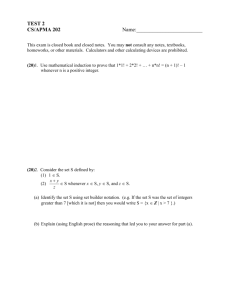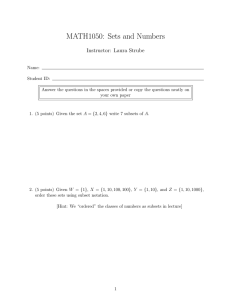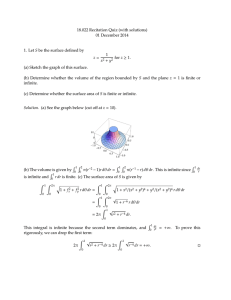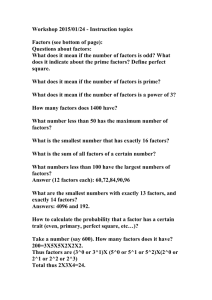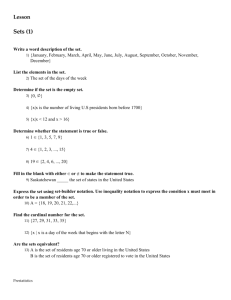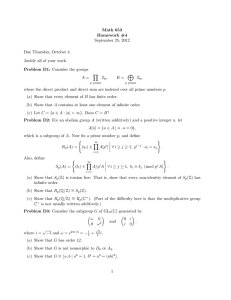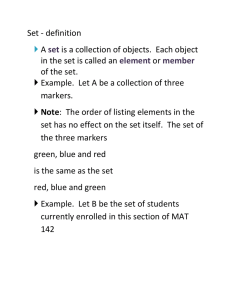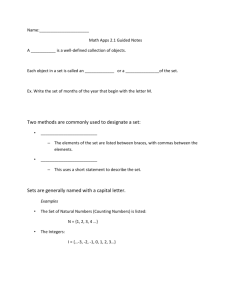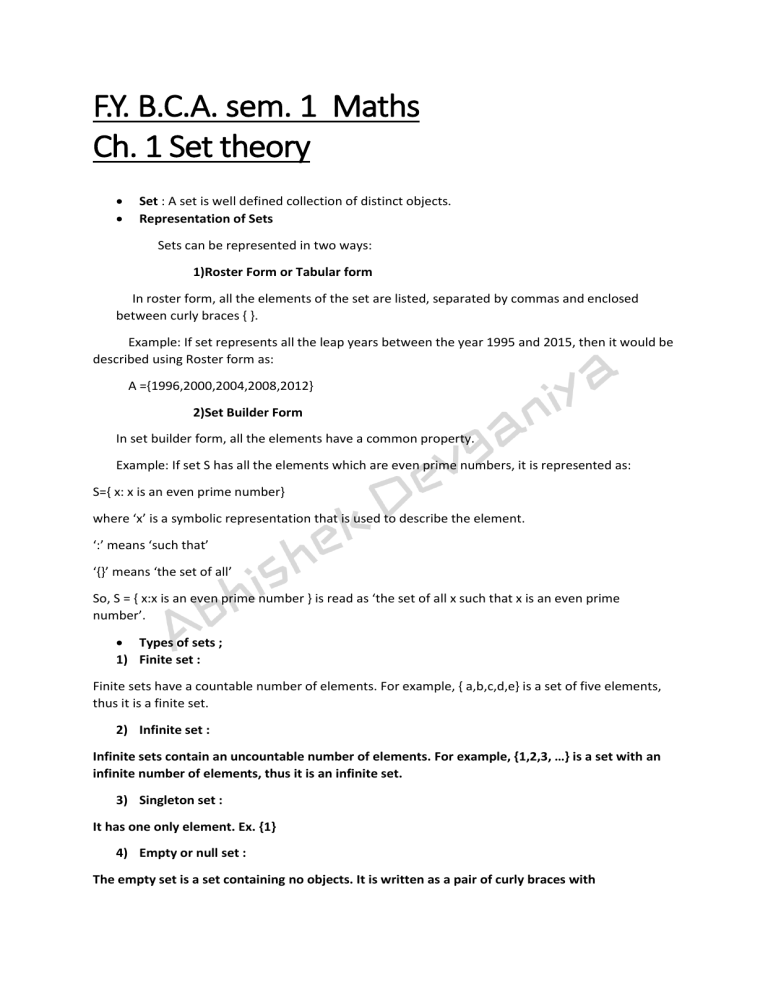
F.Y. B.C.A. sem. 1 Maths
Ch. 1 Set theory
Set : A set is well defined collection of distinct objects.
Representation of Sets
Sets can be represented in two ways:
1)Roster Form or Tabular form
In roster form, all the elements of the set are listed, separated by commas and enclosed
between curly braces { }.
Example: If set represents all the leap years between the year 1995 and 2015, then it would be
described using Roster form as:
A ={1996,2000,2004,2008,2012}
2)Set Builder Form
In set builder form, all the elements have a common property.
Example: If set S has all the elements which are even prime numbers, it is represented as:
S={ x: x is an even prime number}
where ‘x’ is a symbolic representation that is used to describe the element.
‘:’ means ‘such that’
‘{}’ means ‘the set of all’
So, S = { x:x is an even prime number } is read as ‘the set of all x such that x is an even prime
number’.
Types of sets ;
1) Finite set :
Finite sets have a countable number of elements. For example, { a,b,c,d,e} is a set of five elements,
thus it is a finite set.
2) Infinite set :
Infinite sets contain an uncountable number of elements. For example, {1,2,3, …} is a set with an
infinite number of elements, thus it is an infinite set.
3) Singleton set :
It has one only element. Ex. {1}
4) Empty or null set :
The empty set is a set containing no objects. It is written as a pair of curly braces with
nothing inside {} or by using the symbol ∅.
5) Equal sets :
Two sets are equal if they have same elements.
Ex. S = { 1,2,3 }
T = { 3,2,1 }
Here S and T sets are equal sets.
6) Equivalent sets :
Two sets are equivalent if they have same number of elements.
Ex. S = { 1,2,3 }
T = { a,b,c }
7) Subsets of a set :
If all the elements of a set A are the elements of a set B then A is said to be a subset of B.
Symbolically we write , A ⊆ B ( A is subset of B )
Ex. A = { 1,2,3 }
B = { 1,2,3,4,5 } then , A ⊆ B
8) Proper sub sets :
If all the elements of a set are the elements of a set B and at least one element of B is not an
element of set A , then set A is called proper subset of B.
Symbolically we write , A ⊂ B
Ex. . A = { 1,2,3 }
B = { 1,2,3,4 } then A ⊂ B
9) Power set :
The family of all the subsets of a given set is called its power set.
Ex. A = { 1,2 }
P(A) = { ∅ , {1} , {2} , { 1,2 } }
10) Universal set :
A parent set from which all different subsets are considered is know as an universal set for
particular situation.
Ex. A = { 1,2,3,4,……….}
B = { 2,4,6,………..}
Union of sets :
The union of two sets S and T is the collection of all objects that are in either set. It
is written S ∪ T . Using curly brace notion
S ∪ T = {x : (x ∈ S) or (x ∈ T )}
Suppose S = {1, 2, 3}, T = {1, 3, 5}, and U =
{2, 3, 4, 5}.
Then:
S ∪ T = {1, 2, 3, 5},
S ∪ U = {1, 2, 3, 4, 5}, and
T ∪ U = {1, 2, 3, 4, 5}
Intersection of sets :
The intersection of two sets S and T is the collection of all objects that are in both sets.
It is written S ∩ T . Using curly brace notation
S ∩ T = {x : (x ∈ S) and (x ∈ T )}
Suppose S = {1, 2, 3, 5},
T = {1, 3, 4, 5}, and U = {2, 3, 4, 5}.
Then
S ∩ T = {1, 3, 5},
S ∩ U = {2, 3, 5}, and
T ∩ U = {3, 4, 5}

